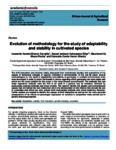Use este identificador para citar ou linkar para este item:
http://www.alice.cnptia.embrapa.br/alice/handle/doc/1045315Registro completo de metadados
| Campo DC | Valor | Idioma |
|---|---|---|
| dc.contributor.author | CARVALHO, L. C. B. | pt_BR |
| dc.contributor.author | SILVA, K. J. D. e | pt_BR |
| dc.contributor.author | ROCHA, M. de M. | pt_BR |
| dc.contributor.author | OLIVEIRA, G. C. X. | pt_BR |
| dc.date.accessioned | 2016-05-19T11:11:11Z | pt_BR |
| dc.date.available | 2016-05-19T11:11:11Z | pt_BR |
| dc.date.created | 2016-05-19 | pt_BR |
| dc.date.issued | 2016 | pt_BR |
| dc.identifier.citation | African Journal of Agricultural Research, v. 11, n. 12, p. 990-1000, Mar. 2016. | pt_BR |
| dc.identifier.issn | 1991-637X | pt_BR |
| dc.identifier.uri | http://www.alice.cnptia.embrapa.br/alice/handle/doc/1045315 | pt_BR |
| dc.description | The GxE interaction only became widely discussed from evolutionary studies and evaluations of the causes of behavioral changes of species cultivated in environments. In the last 60 years, several methodologies for the study of adaptability and stability of genotypes in multiple environments trials were developed in order to assist the breeder's choice regarding which genotypes are more stable and which are the most suitable for the crops in the most diverse environments. The methods that use linear regression analysis were the first to be used in a general way by breeders, followed by multivariate analysis methods and mixed models. The need to identify the genetic and environmental causes that are behind the GxE interaction led to the development of new models that include the use of covariates and which can also include both multivariate methods and mixed modeling. However, further studies are needed to identify the causes of GxE interaction as well as for the more accurate measurement of its effects on phenotypic expression of varieties in competition trials carried out in genetic breeding programs. | pt_BR |
| dc.language.iso | eng | eng |
| dc.rights | openAccess | eng |
| dc.subject | Adaptabilidade | pt_BR |
| dc.subject | Estabilidade | pt_BR |
| dc.subject | Melhoramento genético | pt_BR |
| dc.title | Evolution of methodology for the study of adaptability and stability in cultivated species. | pt_BR |
| dc.type | Artigo de periódico | pt_BR |
| dc.date.updated | 2017-07-19T11:11:11Z | pt_BR |
| riaa.ainfo.id | 1045315 | pt_BR |
| riaa.ainfo.lastupdate | 2017-07-19 | pt_BR |
| dc.identifier.doi | 10.5897/AJAR2015.10596 | pt_BR |
| dc.contributor.institution | LEONARDO CASTELO BRANCO CARVALHO, ESALQ; KAESEL JACKSON DAMASCENO E SILVA, CPAMN; MAURISRAEL DE MOURA ROCHA, CPAMN; GIANCARLO CONDE XAVIER OLIVEIRA, ESALQ. | pt_BR |
| Aparece nas coleções: | Artigo em periódico indexado (CPAMN)  | |
Arquivos associados a este item:
| Arquivo | Descrição | Tamanho | Formato | |
|---|---|---|---|---|
| AJAR2016.pdf | 528,31 kB | Adobe PDF |  Visualizar/Abrir |









